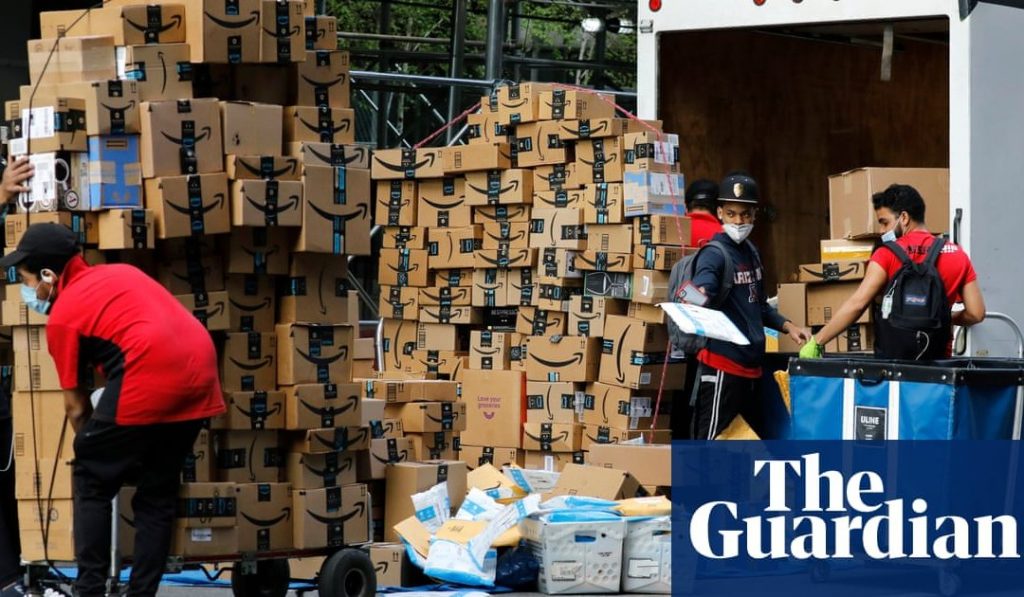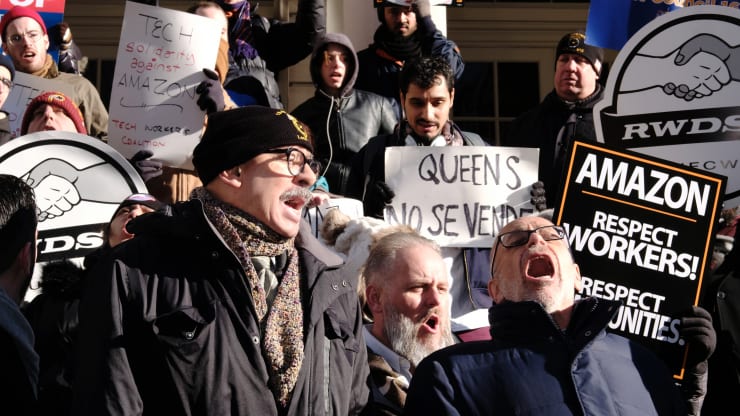KEY POINTS
- Amazon has handled to keep unions out of its ranks since the business’s founding in 1994.
- A recent string of occasions appears to reveal the extent of Amazon’s efforts to prevent unions and track work environment unrest.
- One Amazon storage facility staff member is trying to organize his coworkers by means of an online platform out of an issue for privacy and privacy.
Amazon warehouse employees have a long history of upsetting for modification. But the coronavirus crisis has produced brand-new momentum for employees to speak openly about workplace conditions.
Considering that March, staff members have held demonstrations to require much safer working conditions, developed online petitions to accentuate their issues, and formed new worker groups. The surge of staff member advocacy has raised the concern of whether labor unions may attempt to take the minute to arrange Amazon employees.
Between March and September, the company employed more than 1.37 million front-line Amazon and Whole Foods employees in the U.S. That number does not consist of the 10s of thousands of contracted motorists who are accountable for Amazon’s last-mile deliveries.
Unionizing Amazon’s workforce would be an uphill fight. The business has managed to avoid significant labor unions since its founding in 1994. Labor unions have arranged a few of Amazon’s European workforce, but no U.S. facility has successfully formed or signed up with a union.
“Amazon has always been actively attempting to discourage staff members from arranging unions,” said Marcus Courtney, a longtime labor supporter who attempted to unionize call center workers at Amazon in the early 2000s. “That was real 20 years ago and it’s real today.”
Unions stand to disrupt the level of control that Amazon has over its warehouse and shipment employees, like their ability to unilaterally set the speed of work and hourly incomes, said Tom Kochan, a teacher of industrial relations, work and employment at MIT.
“Amazon manages everything from bathroom breaks to communication with other staff members,” Kochan stated. “If a union can be found in, they’re going to lose some of that control and that’s ultimately what they fear most.”
Tracking workplace discontent
A string of recent events reveals the extent of Amazon’s efforts to prevent unions and track office unrest.
CNBC formerly reported that Amazon posted a job listing for 2 intelligence analysts who might keep track of “labor organizing risks” and other sensitive subjects, and report their findings to “internal stakeholders, up to and including executive leadership.” Amazon later on erased the job listings and said the task descriptions were incorrect.
Amazon attracted further examination previously this month after Recode reported that it looked for staffing and funds to buy software that would assist in better examine and visualize data on unions, called the geoSPatial Operating Console, or SPOC. In September, Vice reported that Amazon’s HR department appeared to be monitoring worker listservs that were hotspots for worker activism. A different Vice report found Amazon corporate staff members were keeping track of closed Facebook groups used by contracted Flex motorists to track scheduled strikes and organizing activity.

Amazon has denied that these programs were developed for finding and suppressing union activity. However, in spite of its guarantees, some storage facility employees say they view security and the capacity for retribution as a threat to unionization efforts.
Politicians, labor unions, and employee rights groups also remain hesitant of the company’s views on staff member arranging. Recently, senators consisting of Elizabeth Warren (D-Mass.) and Bernie Sanders (I-Vt.) wrote a letter to Amazon CEO Jeff Bezos looking for more info about the actions Amazon takes when it becomes mindful of an active organizing project.
“The truth that Amazon has chosen to heavily purchase systems to strike back against the flexibility of expression about hazardous and unhealthy working conditions, and to describe organizing efforts as dangers against the business equivalent to those presented by hate groups and terrorism, is undesirable,” the senators wrote. “Labor organizing campaigns are a lawfully safeguarded activity.”
When asked about its position on unions, Amazon has formerly indicated the quick pace of development in its warehouses and the value of direct interaction between managers and staff members, both of which might be affected by a unionized workforce.
Amazon representative Lisa Levandowski told CNBC in a statement that the business appreciates employees’ right to join or not join a union.
“Throughout Amazon, consisting of in our operations facilities, we place enormous worth on having everyday discussions with each partner and work to make certain direct engagement with our employees is a strong part of our work culture,” she included.
Amazon also offered interviews with several warehouse employees who stated they did not wish to sign up with a union.
“For me, I have been here almost four years and that’s not something that I desire,” said Abdirizak Abdi, a procedure assistant at Amazon’s Shakopee, Minnesota, storage facility. “I’m happy and delighting in the environment and what they do for our clients and our associates too.”
Allison Clawson, who’s also a process assistant at the Shakopee facility, agreed with Abdi and stated the company encourages employees to voice their issues with managers, especially through the “Voice of the Partner” whiteboard in the workplace.
“I have never satisfied a manager that has never made time to talk to me if I had expressed a concern or asked if they had time to talk,” Clawson added.
When asked about the purpose of the SPOC tool, Levandowski said Amazon sought funding for a software application that allows geospatial mapping, which would allow the business to look at numerous occasions happening outside its structures, such as big events, natural disasters, and power interruptions, and weigh how they’d affect employees.
Levandowski didn’t state whether Amazon keeps an eye on possible union activity in e-mail interactions or whether it would track such activity by means of the SPOC tool. The business uses open e-mail forums and other approaches to gather staff member feedback at scale, she stated. Amazon stopped aggregating info from closed Facebook groups, like what was detailed in the Vice report after it discovered one company system was doing so, Levandowski stated.
“That approach does not fulfill our standards,” she added.
Old-school strategies
Amazon isn’t the only big business that has established robust methods for monitoring worker dissent. Walmart, the world’s largest private company, has also been implicated in keeping track of employee discussions on Reddit. Employees at fellow tech giant Google formerly alleged the company created a tool to flag possible organizing activity.
But Amazon has established credibility among union organizers as being especially aggressive.
“Walmart did get a lot of heat for its labor practices, however, I think it has been supplanted by Amazon,” stated Iain Gold, a director with the Teamsters, which is one of the numerous major labor unions that has engaged with Amazon storage facility and delivery workers. “Amazon has taken spying on employees and attempting to comprehend workforce behavioral patterns or preferences to the next level.”
Some kinds of security are acceptable under the National Labor Relations Act, a federal law that secures staff members’ right to arrange and prevents personal corporations from participating in unreasonable labor practices. For example, companies can keep an eye on email communications in the office. Gathering data to avoid union arranging before it occurs is “frankly just excellent organization,” stated Jeff Wilson, lawsuits director at law practice Young Basile.
However, some strategies are considered illegal, like creating the impression of security for the function of chilling efforts at unionizing or spying on personal Facebook chats, Wilson stated.
“The monitoring itself is not an NLRA infraction, but it’s how the company executes and carries out that policy where things might cross the line,” Wilson stated.
Other surveillance tactics, like reports of Amazon’s Whole Foods developing a union tracking system, are just among the methods “sophisticated employers” have gotten more adept at squashing union activity, Kochan said.
“They will work with not only attorneys but anti-union specialists,” Kochan stated. “They’ll invest in videos to emphasize how highly they’re opposed to union organizing. It’s extremely tough for a union to get rid of that.”
Courtney said he experienced a few of these tactics 2 years ago when he and a department of the Communications Employees of America helped launch a campaign to organize hundreds of Amazon’s customer support employees in Seattle. Amazon later closed the call center where the staff members worked as part of a broader restructuring.
Before Courtney became associated with the unionization effort at Amazon, he also attempted to organize Microsoft agreement employees in the 1990s. Courtney said he felt Microsoft was “more hands-off” during the procedure, while Amazon appeared to adopt the anti-union methods that prevailed in old-line industrial centers.
Amidst the unionization effort, Amazon developed a site for supervisors to set out warning signs that workers are attempting to arrange. It also held regular conferences to argue why unionization would be bad for the company.
“I believe Amazon took a much more active and proactive role in trying to dissuade employees from joining which was unusual at the time in the innovation industry,” Courtney stated. “A lot of the stuff we’re seeing today is just the growth of what was occurring back then.”

Outsmarting Amazon
Some employees inside Amazon and at gig economy businesses like Instacart and Target’s Shipt have moved their organizing activity online to get the privacy and anonymity that’s not always possible on the store flooring or in the break room. Facebook groups and encrypted chat apps such as Signal and Telegram have ended up being progressively popular tools for employee advocacy both during and before the pandemic.
John Hopkins, who operates at Amazon’s San Leandro, California warehouse, is attempting to unionize his work environment with digital tools. Hopkins has been an outspoken critic of Amazon’s labor practices and, earlier this year, helped launch Bay Location Amazonians, a working group that aims to protect more secure working conditions at the company.
Hopkins is developing a new online arranging platform on Zoom’s Keybase, an end-to-end encryption and security service that also provides protected messaging and file sharing. To use the platform, workers will need to create a decentralized identifier, comparable to a bitcoin address, that’s identifiable to others who’ve joined the network but appears confidential to anyone who isn’t authorized.
Ultimately, Hopkins hopes that his coworkers will be able to utilize the platform to sign a union permission card digitally– a practice the National Labor Relations Board began enabling in 2015.
Hopkins said he was partly motivated to create a new platform because other online worker groups don’t constantly feel like a safe place for an open conversation about unionizing.
“If you go on the Facebook online forums, there are many discussions where you’ll start to have the starts of an intriguing discussion, and after that somebody will come in and remind everybody that you’re not truly safe,” Hopkins stated. “And so it cools conversation without [Amazon] even having to in fact go through with it.”
The goal is to offer storage facility employees self-confidence that they have control over their details, Hopkins stated. He acknowledged that it will spend some time to inform coworkers about how the system works, but he stays positive that there will be a willingness to learn.
“Among the things that annoy me is that it very much feels like there is a presumption that folks in the storage facilities are ignorant and that’s not the case in my experience,” Hopkins said. “I’m honestly not taking the perspective that any of this is too complicated for workers to grasp.”
















